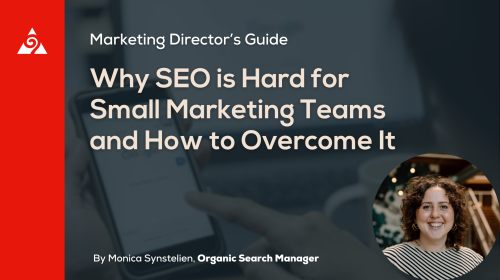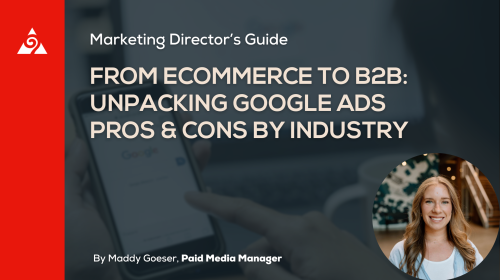In the second episode of How I Work, Augurian chats with Josh Werner, from Calabrio about his role as the Director of Demand Generation. Watch to find out about how his team bridges the gap between marketing and sales, from crafting powerful SEO content to managing a robust tech stack.
Subscribe to SaaS Scoop to make sure you don’t miss out on the next episode of the ‘How I Work’ video series.
Learn more:
Josh Werner
Calabrio
transcription
Josh Becerra: Hello everybody, is Josh Becerra from Augurian. I’m here with Josh Werner, who is the director of demand gen at Calabrio. Thanks for being here Josh.
Josh Werner: Happy to be here. Thanks for having me.
Becerra: Yes. Awesome. We’re doing this segment with SaaS marketers on how you work. I’ve got a couple of different questions for you. Maybe you could give us just a real quick rundown of Calabrio and your role and then we’d love to hear about how you’re investing your marketing dollars.
Werner: Yes. Absolutely. As Josh mentioned, I’m the director of demand generation. It’s a wide variety of activities but it’s really largely how do you drive prospect and customer demand through all the different ways that you can go about doing that. Me and my team primarily focus on digital marketing, the website and SEO aspects. We really get involved with content as well marketing operations and automation events.
I also have a business development team that reports through me. They are a big part of this process. Largely, my team is the team that bridges that gap between marketing and sales and do that really form hand-off or we’re giving really qualified opportunities. I will say a little bit about Calabrio too. We’re on this hockey growth curve just straight up.
Becerra: It’s a good place to be.
Werner: Yes, it is. It’s fine but it’s crazy we’re a growing company and so with that, you’ve got to be the right person to be able to deal with that but it’s changing constantly. We’re already going through a series of acquisitions, we most recently acquired this company named Teleopti out of Sweden. I’ll talk about this during our conversation but just the global nature of these type of programs is something that’s different, a new challenge and it’s been fun. We’re getting that rhythm.
Becerra: Well, that’s awesome man. Well, I really appreciate it. I know you’re a busy guy and you’re running around a little bit with your hair on fire with all the acquisitions and things but thanks for taking the time. Tell us a little bit about where you’ve seen great returns and what you’re focusing on right now.
Werner: Yes. I think the biggest one and people have heard this is- I’m not the first person to say this by any means but account-based targeting programs or very commonly account-based marketing programs. We call them targeting because it’s very much in partnership with sales on this. What we found through that is taking that really laser-focused, sniper approach to accounts is, the returns are so much greater when we do that.
We can really focus on driving demand in enterprise-level accounts. That’s been something that we’ve had an initiative around that we want to go after enterprise-level accounts. This was our way to do that. You got to look holistically at the buying committee and team at these organizations taking a wider view than just a one-off lead and bringing that all together is something that we’re very much focused on.
We launched our first program at the end of 2017 and we continue year after year to invest more heavily in that aspect to the tune of– I’ve got a team of eight BDRs, global BDRs right now who are asking for 11 more next year to be able to support sales for us.
Becerra: That’s some hockey stick growth, yes.
Werner: Yes, it is. It’s exciting time on a team, just they are such an instrumental part of this program allow us to go out. We can scale a lot of the marketing programs but when it comes to the prospecting efforts that matter, that needs to happen with the BDR team. That’s a big area. We’re also investing in some of the just normal, I think, digital things. Like SEO is a big thing for us.
We’ve undertaken a big SEO project the last year the stand-up pillar content, just right content a little bit differently and make sure that we’re ranking in the search engines and then converting them into our database for ongoing nurture and getting them in the hands of the BDR. We’re working on that engagement aspect of digital as well.
Becerra: Yes. A couple of things around the SEO side with the content, how are you going about creating that? Do you have an internal team? How are you identifying what the hub or the topic areas are and then who’s doing the writing for you? How are you set up?
Werner: Well, it’s a hodgepodge here a little bit. We work through a variety of people but we have– Well, largely why we started this because a lot of businesses and especially SaaS companies are in the same boat. You write product-related content or your product content but that’s not definitive content on a topic and it’s talking about the product and that type of thing.
It’s a different type of search intent you’re going for when you’re putting together pillar pages. We had a pretty clear definition of what our core pillars were and it’s based off of the things that we sell for in the market.
Becerra: Sure.
Werner: You need all this cluster content around it and you write it in thought leadership way and where we haven’t been as focused in the past as formatting those blogs to have the right H tags, and titles.
Becerra: The technical SEO.
Werner: Yes, it’s that on-page stuff that matters too, right? Just having it be long-form so it’s definitive in the eyes of Google and then interlinking that content in with other content and whatnot. We’re going through this long process of doing that right now.
Becerra: Super smart.
Werner: It’s been a series of working with internal experts to help us craft content. We work with an external content agency called Words that Work in Town that does a fantastic job of building out content for us. We’re beg, borrow and skill-up from wherever we can.
Werner: – We have what we need. We work through a bevy of people.
Becerra: Yes. Cool. When it comes to account-based marketing, you were talking about this earlier, my experience is in order to really do that well there is two key things. One is you’ve got to have the right tech stack and you got to understand there is a marketing automation play in there. Tech stack is really important if you want to do it right.
Secondly, that sales hand-off, the alignment between sales and marketing really has to be good and there has to be good data flowing into CRM so that marketing can take advantage of that data to help salespeople maybe prioritize who the hottest leads are and things like that. Tell us a little bit about your tech stack and then how you guys are managing that sales and marketing alignment.
Werner: Yes. I’m just very lucky to have a very robust tech stack here that allows us to be able to do that. From outbound programming, we use so many tools just like many marketing Google Analytics and stuff, all this free stuff. Core technology that we’re spending a significant amount of budget on, that really drive these ABT programs for us is- everything centers around Salesforce and Pardot. Salesforce is like the centralized working zone and all the notes.
That’s where the sales and BDR team works off of. We look to roll up everything under an account record and in Salesforce. You have Pardot which is the brains behind the operation and allows you to do all the– I call it all the time the backbone behind everything that we do because it’s the smarts of it, how are we going to route things, the notification engine, there is a lot of communication engine in there.
Obvious everything revolves around that. We’ve got some other cool technology. We have Terminus that we utilize for display advertising and intent monitoring and multi-touch attribution reporting and those things are all critical. The intent monitoring there is really important because that helps us boil up accounts and bring to the table accounts that we feel we should be going after based on search intense at these organizations.
It also allows us to see accounts that have been interacting with our digital properties which is again another way to prioritize. A huge thing with account-based targeting programs is, it’s not that it’s scaling it too big is the problem, it’s focusing on the best accounts that you can.
Becerra: That prioritization.
Werner: In order to do that correctly and go into the large buying team and prospect appropriately it takes a lot of time. You got to focus on the best few. Terminus allows us to do that and [unintelligible 00:08:59] with the display. We also use ZoomInfo from a graphic contact mapping, LinkedIn sales navigator is important from a prospecting angle and research of prospects. We use outreach.io, that’s a prospecting automation tech. The BDR is in that all day. It’s basically what their day of prospecting is in front of them very critical to our success. There is a lot of efficiency.
Becerra: It sounds you’re a huge advocate for leveraging tools and getting as much data as you possibly can and then using that to help the sales team really prioritize.
Werner: Yes. With any of this though you can’t just go out and get a big tech stack and be like, “Move man, I got myself an ABT strategy.”
Werner: It just fuels it. If you don’t have people to run this stuff, if you don’t have people that act on the data, you’ve got to get your priorities straight with how you’re going to run a program like this. Don’t go out and just go buy a big tech stack and thinking that’s going to solve it, you need the right people to be able to manage that and leverage the data.
Becerra: Yes, that’s good advice.
Werner: You asked another question around data. Yes, sure, data is going to inform our efforts here. I’m in a really lucky position where I manage BDRs. They do like 80% of the prospecting when it comes to these targeted accounts. What sales rep is not going to love to have that type of a resource? That’s a natural connection point between me and the sales teams.
The BDRs partnered very closely every day with their sales reps and we’re aligned the same goals. For me, that sales alignment has been easier than in the past when you are just working with the sales department to go prospect. They don’t love doing that.
Becerra: That extra layer helps as a buffer and acts as a translator, I would say.
Werner: Yes.
Becerra: Cool. You had alluded to some of this earlier, but biggest challenge today that you are facing?
Werner: For me, it’s scaling these programs that we built in North America and making them global programs. While we have had global operations, after this acquisition that we had, especially of this Teleopti product, they were largely, I think like 70% of their revenue came from international markets. That’s good from a Calabrio perspective, because we’re just broadening our reach, but it adds challenges in markets that I haven’t necessarily been in or heavy in, and really focused our time and effort. I’m doing a lot of work right now between, “Okay, what countries absolutely need to be spoken to in their native language and what assets then do we need for that?”
“Can the tech go out and reach these people in a wider geographic region?” It’s been fun to go back to the drawing board with some of that stuff, and we’re going to see what works and learn from it, like we always do, but yes, that keeps me up at night. Those are things. We’re doing a lot of planning around that right now.
Becerra: Are you starting to see the need for a distributed team and everything then as well across the globe and managing all that?
Werner: Yes, that naturally happened. During some of this acquisition, and just as Calabrio grows organically. I have a BDR team in London, as well as here in Minneapolis in our headquarters, but I also have a marketing team in Stockholm, Sweden. They largely know those regional differences, but we approach things a little bit differently than maybe they did. We got to rethink how we’re doing that. That BDR layer is a really big thing that Teleopti actually didn’t have. Now we do and we’re introducing that, so we’re going through that transition.
Becerra: That’s great. All right. Last question is about what you’re excited about for 2020 from idea, experiment standpoint or anything that you see on the horizon?
Werner: Yes, I gave this some thought, because we obviously talked about what questions you’d be asking here. I got two things, and I don’t think that they’re crazy, forward thinking things, but they’re things that for Calabrio, and at the right time here, we’re ready to hit these things.
One of the things is making the prospect and customer journey more personalized. We’ll look through this website for granular sona development, and just understanding the needs of specific people and being able to talk in their language more. The more that we can do that, the better. It just makes your message resonate. I would also say, the other thing, and there’s a lot of technology that’s allowing this to happen.
Really, I don’t think this is going away, but just an account-based approach versus a contact or lead-specific approach. You’re not looking at things as these small sums of like, “Okay, we got to lead for just this person.” Sure, you got to look at that, but what does that boil up to from an account perspective? I think the last stat I read is something like, there’s 11 decision makers in B2B enterprise level tech purchase. We got to go get all those people on board.
Becerra: Connect them all under one account in the CRM and understand who’s interacting with the site and everything?
Werner: Yes. That’s not as easy. It’s not as easy as it sounds like. Maybe it shouldn’t be, but there are tools and technology that are coming out to help in that, but again, you need the right people to be able to act on that and bring it together. We’re working through that. It’s a work in progress, but lead-to-account mapping tool is a big thing in order to help that and it starts there, but then there’s more insights that you can gain. That’s where we’re going.
Becerra: Awesome. Well, I really appreciate your time, man. This was great. Continue that hockey stick growth. Get out there, go to Sweden and make it happen.
Werner: Yes. All right, thanks. Happy to have joined you and hopefully this helps some other people in the similar situations.
Becerra: Yes, for sure. This is super fun. All right, thanks, Josh. Take it easy.
Werner: All right. Well, see you.
Becerra: All right. Bye.



